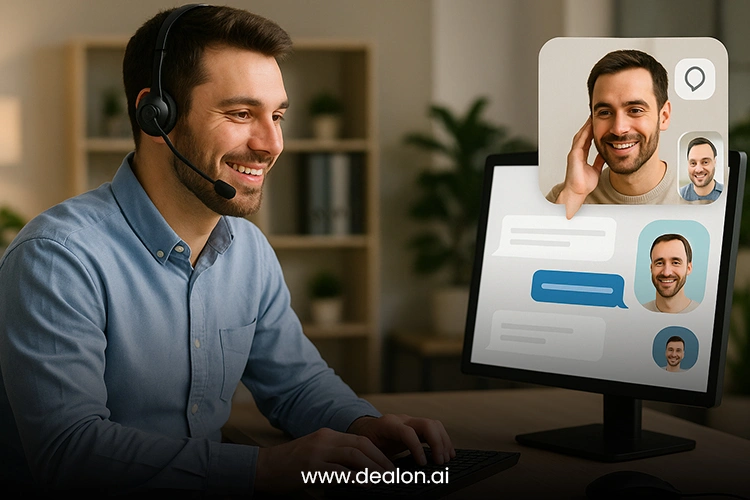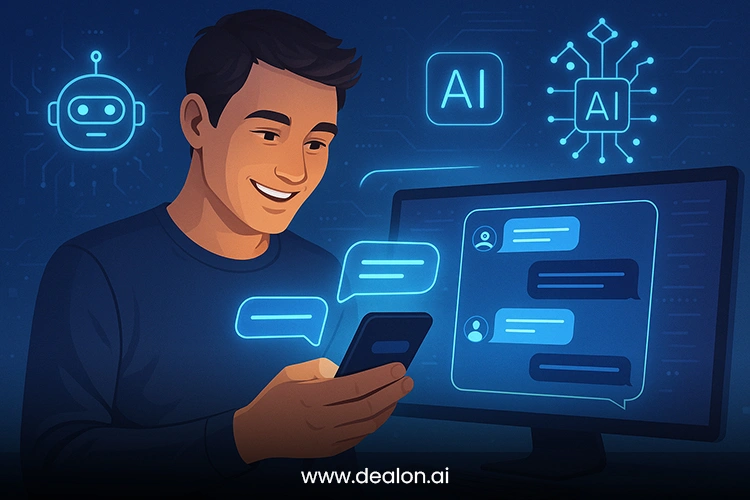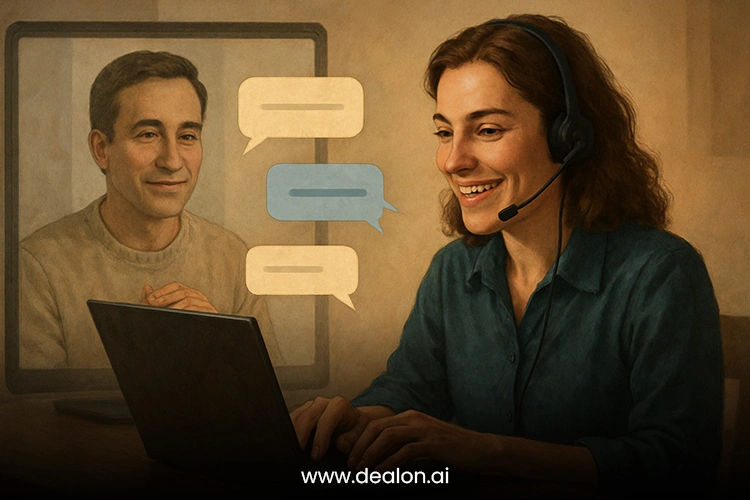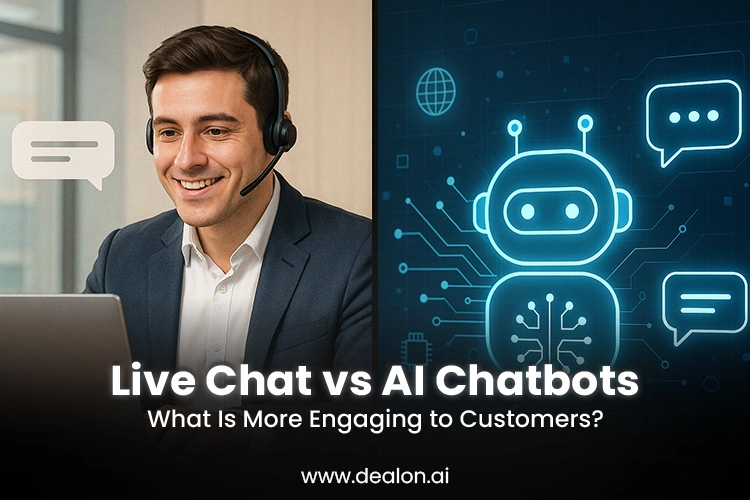As corporate enterprises continue to advance to the digital era, the requirement for smooth, effective, and personalized customer interaction cannot be brought up at a more pivotal moment. Customers have never been so demanding before, so firms are seeking a means to give a real-time, viable reply to their customers, regardless of the time of day or the number of requests. Enter live chat and AI chatbots, two mighty tools that will make the process of communicating more effective and the customer experience higher.
Human with their personal touch can address urgent personal interactions in live chat, and at the same time, automation, extensibility, and 24/7 operations represent an underlying benefit of AI chatbots. The two approaches are sought to raise the customer satisfaction level, speed responses, and elevate conversion rates; however, each has its strong points and shortcomings. Live chat is a real-time, subtle mode of communication with human interlocutors that can offer an empathetic response to complicated questions. On the contrary, AI chatbots are very effective in helping to process large numbers of standard requests that do not require the involvement of human resources.
But as the development of AI technology continues and the behavior of consumers changes, the question companies face today is: which solution indeed provides a better engagement? Is the human touch of live chat more critical than automation and efficiency of the AI-powered chatbots, or is the future a hybridization of these technologies?
This post will explore the particular advantages and disadvantages associated with live chat and AI chatbots and give a complete analysis of the two types so businesses can understand the way companies are adapting to new changes and engage customers effectively and successfully pinpoint the proper solution to their individual needs. Be it scaling the customer service or overall customer experience, the concept of these two tools will be key to keeping up with the game in the year 2025.
Also Read: Manual Marketing funnels versus AI-automated funnels
What Is Live Chat?

Live chat refers to a real-time text-based method of business-customer interaction, where agents of a business communicate with the customers either in person or by a manned operator. It is an effective service that provides individual support in the immediate solution of problems and issues to provide customers with information and accompany them on their way. Live chat is more relational and empathetic than other customer service channels as it utilizes the human aspect in communication.
The best benefit of live chat is its real-time nature. Customers are not required to wait long on hold or to send an email and spend time waiting to receive answers anymore. Instead, they can interact directly with a representative who will be able to answer questions, troubleshoot, and give precise suggestions rapidly. The live chat option would be especially useful in the industry where the customer problem might be more specific or even complicated (tech support or healthcare sector, financial services, etc.). Human agents must be eligible to use their judgment and intuition to overcome the difficulties that are too complex to solve by automated systems; this is a critical aspect in building trust and customer satisfaction.
Live chat is, however, limited. With the human agent only being in a position to handle a single conversation, delays may become relatively high when different customers require attention during off-peak hours. This may result in delay and customer dissatisfaction, especially during the peak period. There is also a system of live chat, which is usually operational during business hours, so customers in other time zones or who have matters at different times will just be frustrated. Other companies overcome this by providing extended time or outsourcing assistance services, which may accompany the high cost of operation.
What are AI chatbots?

AI chatbots are an innovative step towards interacting with customers that puts their advanced insight into play, applying machine learning methods, the usage of NLP, and data analytics to imitate a conversation with humans. Such intelligent systems can boast capabilities to operate queries by clients and give responses immediately, offering a wide array of features, including support, lead generation, and appointment scheduling, among others.
AI chatbots are available both day and night compared with live chat, hence giving businesses a capability to target their customers at any time of the day or night, irrespective of where they are on earth or even the clocks in their place. This 24/7 access comes in handy, especially with global companies, as they can respond to customer requests at non-business hours.
Data-driven insights provided by AI chatbots can personalize responses and make relevant recommendations, too. Understanding previous interactions, purchase history, and customer profiles allows the AI chatbots to predict the need, provide personalized content to a particular user, and send them to specific resources referring to their preferences. To give an example, an AI chatbot on an online store may suggest products based on habits or purchasing history, and this will increase the shopping experience.
Moreover, AI chatbots have the potential to handle common questions (tracking orders, password recovery, and commonly asked questions) without interrupting human agents to manage the more complicated concerns. This avoids human resource burnout and enables them to attend to the severe cases, whilst at the same time, customers get instant, correct responses to simple questions. Despite the excellent performance of AI chatbots regarding automation and efficiency, they are not very effective in dealing with subtle or highly emotional situations. In such cases, chatbots may be configured to transfer the conversation to a human agent so that the customers can get the most suitable help.
Live Chat: The People Side of Engagement

The unique strength of live chat in customer involvement lies in the human factor. In contrast to chatbots based on pre-scripted scripts and data models, live chat enables the customer to communicate with a human being. Such an intimate approach promotes trust and a feeling of genuineness and is vital, especially on sensitive issues or profound questions. To most customers, communication with a human being is reassuring, and it removes the fears that they have in dealing with automated systems.
The possibility of solving delicate, complex problems is one of the significant advantages of live chat. Live agents introduce emotional intelligence and temporal insights to determine whether customers are undergoing service interruptions, technical issues, or need any advice with complex products. These human values are essential in instances where customer dissatisfaction needs to be dealt with or where some delicate problems need to be handled.
Such cases can change a bad experience to a good one because of the problem-solving skills and empathy of a live agent. The ability to provide customers with custom responses means that such a personal approach will make customers feel heard, understood, and appreciated, and it is impossible to duplicate the experience that live chat can offer with the current success achieved by AI chatbots.
The other benefit of live chat is that it is instant. Customers love the opportunity to get responses in real-time, and this is what is covered by live chat to the extent that it satisfies their needs. Compared to the classic support channels, including email or phone calls, where the response time may be considerably longer, live chat allows delivering feedback as quickly as possible, so that the customer does not feel left alone and frustrated at having to wait before solutions are offered. This real-time connection gives urgency and emphasis on the idea that businesses look after their customers.
Nevertheless, there are also drawbacks to live chat. The human agents can deal with one conversation at a time, thus making them subject to delays, particularly at peak hours. As a business continues getting more inquiries, the longer it remains before they are served, and this may spoil the whole experience of the customers. There is also the live chat to be considered, and the live chat tends to be limited to business hours, so it would not be as appropriate for businesses that deal with global customers or those that need 24/7 support.
AI Chatbots: Automatization and Efficiency during Engagement
Although live chat depends on the personal feeling of the human contact, AI chatbots are designed to introduce automation, scale, and efficiency in contact with their customers. Such bots are more effective and competent in giving accurate responses to common questions (FAQs) in real time, responding to predictable queries within a short cycle.
Through the aid of sophisticated natural language processing (NLP), AI chatbots can parse the inputs of the customers with a stunning degree of accuracy, even in cases where questions are asked in a different form or are ambiguous. Such an ability will allow chatbots to respond to broad categories of questions, so businesses could provide fast and reliable answers, even in instances when customer questions are varied in complexity.
The main benefit of AI chatbots is that they can handle a large number of interactions at a time. Compared to live chat, where users have to wait because there are few human agents, AI chatbots will be able to support thousands of simultaneous conversations. The scalability comes in particularly useful to business organizations that have many customers or have high traffic, since it helps in the absence of the bottleneck phenomenon, where many customers may tend to seek the live agent simultaneously. The responses given by AI chatbots are consistent and accurate, with no delay or lack of support, as would have been the case with human-supported support systems; hence, no customer is left behind.
Another way in which an AI chatbot enhances its efficiency is that an AI bot can automate the completion of routine processes. As an example, chatbots can be used to book an appointment, monitor orders, provide a refund, and even provide some product recommendations in accordance with customer activities and history. This not only improves the customer experience but also distributes the resources in the best way possible, whereby the businesses can provide efficient support at the least possible cost to run their businesses.
In addition, AI chatbots can collect valuable information in each communication. They can monitor customer preferences, purchase history, and behaviors, giving a business an in-depth understanding of customers’ needs and pain points. This information can be utilized to adjust marketing plans, customize customer services, and predict customers’ future needs. As an example, a chatbot can detect a pattern of complaints towards one of the features of a particular product and warn the business before problems become serious.
The next great advantage is the forecasting characteristics of AI chatbots. The chatbots can anticipate future customer demand through analyzing past interactions to make relevant recommendations and even to end up in a sale. Such proactive, data-enabled interaction allows businesses to build a better relationship with their customers to the extent of giving them solutions even before they seek solutions.
Which One Provides a Greater Customer Contact in 2025?
Because of the increased innovation and adaptation of the business to changing customer expectations, the issue of which one offers better customer engagement in 2025 between live chats and AI chatbots has been one of the central issues. There is no clear black-and-white to this question, however, because live chat and AI chatbots have their own set of strengths based on the specific business situation, as well as customer expectations and the various levels of interaction.
Live chat is not going anywhere when it comes to the industries where empathy, resolving issues, and giving personal care are the main concepts. Branches like health care, finance, and luxury commodities have to be staffed by human agents who should be able to listen carefully, comprehend subtle issues, and provide customized answers. Customers within these industries usually require some confidence and personalized guidance that AI chatbots, although advanced, may not be able to offer.
Human touch of the live chat is necessary in case of the customers having a sensitive problem or having a complicated query to resolve; in that case, emotions of a human agent are essential and can make a significant impact. Moreover, live chat establishes a relationship between the customer and the brand, and this relationship contributes to the establishment of a trust that is essential in the business industries where consumers have to feel secure and confident when they are consummating their purchases.
Conversely, AI chatbots are better in situations where efficiency, high volumes, and speed of interactions are necessary. AI chatbots can be used by e-commerce websites, tech support provider platforms, and SaaS companies to offer fast, consistent, and dependable answers to frequent customer enquiries. They can handle even hundreds or thousands of conversations at the same time without any delay, which provides round-the-clock, immediate help.
Such scalability proves invaluable to businesses with sporadic traffic or businesses with international customers in other parts of the world in varied time zones. By automating repetitive activities such as order tracking, frequently asked questions, or troubleshooting, AI chatbots will allow businesses to work more efficiently overall and reduce waiting times for customers.
By 2025, both live chat and AI chatbots are likely to be the most suitable solutions for customer engagement. A hybrid strategy lets business entities merge the strong suits of both instruments, and that would yield a smooth experience to customers. With AI chatbots, it is possible to face the simple repetitive questions and provide perfect answers fast, allowing human agents to concentrate on the more sophisticated and high-stakes conversations. Such cooperation guarantees that although companies offer speed and efficiency, which come with automation, they have not lost empathy and the problem-solving skills of live chat agents.
The involvement of AI chatbots in the customer service process will enable businesses to scale their customer support needs without undermining their quality. AI chatbots get better and better each time, as a result of machine learning, creating the ability to provide further personalization and more insight with repeated usage by businesses. In the case of live chat, the more complex, delicate, or high-touch issues are also handled using the expertise provided by a human being to preserve the trust and rapport that customers look forward to.
What will it be like in the Future of Customer Engagement?
Both live chat and AI chatbots are the future of customer engagement in 2025 and beyond; however, they can and should be used strategically. AI chatbots will become more and more significant in the provision of efficient, scalable, and individualized service as consumer demand increases toward immediate responses and uniquely personal experiences. The fact that they can streamline repetitive work, data processing, and come up with trends on customer demands makes them a perfect fit in the 24-hour, digital economy.
Nonetheless, human interaction also plays an important part, primarily when the businesses are based on the level of trust, empathy, and problem-solving, as these are also complicated. The ability to integrate the benefits of AI automation and the emotional intelligence and flexibility of live chat representatives will be the key to remaining competitive and answering various requirements of customers.
By combining the opportunities of both tools, the businesses will be able to make sure that their service is outstanding, not only fast and efficient but also warm, personalized, and heavily involved in the needs of the customer. The hybrid model would mark the future of customer interaction, allowing companies to provide a near-flawless, responsive, and hyper-personalised experience by 2025 and beyond.
Conclusion
Live chat and AI chatbots create different benefits for the engagement strategy of customers. Live chat can provide the touch that human beings need to deal with complicated matters and develop trust, so it is irreplaceable in industries that demand an individual approach. AI chatbots are good at scalability, automation, and efficiency, answering enormous numbers of basic questions and being available at all times of the day. Customer engagement will take a mixture of technologies into the future of 2025, where a balance between speed and personalization is necessary. The advantages of AI chatbots and live chat make it possible to offer superb, convenient, and caring customer service to business customers.

